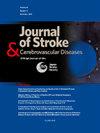A silent surge: Increasing stroke deaths among older adults with atrial fibrillation in the United States (1999-2020)
IF 1.8
4区 医学
Q3 NEUROSCIENCES
Journal of Stroke & Cerebrovascular Diseases
Pub Date : 2025-04-28
DOI:10.1016/j.jstrokecerebrovasdis.2025.108328
引用次数: 0
Abstract
Background
Atrial fibrillation (AF) significantly increases stroke risk, particularly among older adults, leading to severe outcomes and elevated mortality. This study investigates trends and disparities in AF-related stroke mortality among U.S. adults aged 65 and older from 1999 to 2020.
Methods
Mortality data from the CDC WONDER database were analyzed, identifying stroke as the underlying cause of death (ICD-10 codes I60–I69) with AF as a contributing cause (ICD-10 code I48). Age-adjusted mortality rates (AAMRs) per 100,000 persons were calculated. Annual percentage change (APC) and average annual percentage change (AAPC) were used to assess trends over time using Joinpoint regression.
Results
A total of 197,453 deaths were recorded between 1999 and 2020. The AAMR increased from 20.85 in 1999 to 24.09 in 2020, reflecting an AAPC of 0.55 % (95 % CI: 0.19–0.95). Women had a slightly higher overall AAMR (21.69) compared to men (20.38). AAMR for Non-Hispanic (NH) Whites (22.15) was 1.5 times higher than that for Hispanics (14.17). Nonmetropolitan areas reported a higher AAMR (22.68) compared to metropolitan areas (21.03). The West had the highest regional overall AAMR (26.57). States in the top 90th percentile reported nearly double the rates of the lowest 10th percentile states.
Conclusion
AF-related stroke mortality in older adults has risen over the past two decades, with disparities across gender, race, and geography. Targeted interventions are essential to address these disparities and reduce the burden of AF-related stroke mortality.

无声的激增:美国老年房颤患者中风死亡率的增加(1999-2020)
房颤(AF)显著增加卒中风险,特别是在老年人中,导致严重后果和死亡率升高。本研究调查了1999年至2020年美国65岁及以上成年人心房颤动相关中风死亡率的趋势和差异。方法分析来自CDC WONDER数据库的死亡率数据,确定卒中为潜在死亡原因(ICD-10代码I60-I69),房颤为促成死亡原因(ICD-10代码I48)。计算了每10万人的年龄调整死亡率(AAMRs)。使用年百分比变化(APC)和平均年百分比变化(AAPC)来评估随时间变化的趋势。结果1999年至2020年,共有197,453人死亡。AAMR从1999年的20.85上升到2020年的24.09,AAPC为0.55% (95% CI: 0.19 ~ 0.95)。女性的总体AAMR(21.69)略高于男性(20.38)。非西班牙裔(NH)白人的AAMR(22.15)是西班牙裔(14.17)的1.5倍。非首都地区的AAMR(22.68)高于首都地区(21.03)。西部地区的总体AAMR最高(26.57)。排名前90百分位的州报告的失业率几乎是排名后10百分位的州的两倍。结论:在过去二十年中,老年人心房颤动相关卒中死亡率有所上升,且存在性别、种族和地域差异。有针对性的干预措施对于解决这些差异和减少房颤相关卒中死亡率的负担至关重要。
本文章由计算机程序翻译,如有差异,请以英文原文为准。
求助全文
约1分钟内获得全文
求助全文
来源期刊

Journal of Stroke & Cerebrovascular Diseases
Medicine-Surgery
CiteScore
5.00
自引率
4.00%
发文量
583
审稿时长
62 days
期刊介绍:
The Journal of Stroke & Cerebrovascular Diseases publishes original papers on basic and clinical science related to the fields of stroke and cerebrovascular diseases. The Journal also features review articles, controversies, methods and technical notes, selected case reports and other original articles of special nature. Its editorial mission is to focus on prevention and repair of cerebrovascular disease. Clinical papers emphasize medical and surgical aspects of stroke, clinical trials and design, epidemiology, stroke care delivery systems and outcomes, imaging sciences and rehabilitation of stroke. The Journal will be of special interest to specialists involved in caring for patients with cerebrovascular disease, including neurologists, neurosurgeons and cardiologists.
 求助内容:
求助内容: 应助结果提醒方式:
应助结果提醒方式:


